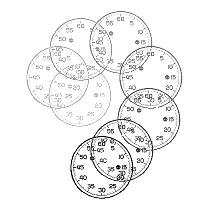 A few years ago we noted the remarkable research by Fried, Mukamel, and Kreiman which reproduced and confirmed Libet’s famous research. Libet, in brief, had found good evidence using EEG that a decision to move was formed about half a second before the subject in question became consciously aware of it; Fried et al produced comparable results by direct measurement of neuron firing.
A few years ago we noted the remarkable research by Fried, Mukamel, and Kreiman which reproduced and confirmed Libet’s famous research. Libet, in brief, had found good evidence using EEG that a decision to move was formed about half a second before the subject in question became consciously aware of it; Fried et al produced comparable results by direct measurement of neuron firing.
In the intervening years, electrode technology has improved and should now make it possible to measure multiple sites. The scanty details here indicate that Kreiman, with support from MIT, plans to repeat the research in an enhanced form; in particular he proposes to see whether, having identified the formed intention to move, it is then possible to stop it before the action takes place. This resembles the faculty of ‘free won’t’ by which Libet himself hoped to preserve some trace of free will.
From the MIT article it is evident that Kreiman is a determinist and believes that his research confirms that position. It is generally believed that Libet’s findings are incompatible with free will in the sense that they seem to show that consciousness has no effect on our actual behaviour.
That actually sheds an interesting side-light on our view of what free will is. A decision to move still gets made, after all; why shouldn’t it be freely made even though it is unconscious? There’s something unsatisfactory about unconscious free will, it seems. Our desire for free will is a desire to be in control, and by that we mean a desire for the entity that does the talking to be in control. We don’t really think of the unconscious parts of our mind as being us; or at least not in the same way as that gabby part that claims responsibility for everything (the part of me that is writing this now, for example).
This is a bit odd, because the verbal part of our brain obviously does the verbals; it’s strange and unrealistic to think it should also make the decisions, isn’t it? Actually if we are careful to distinguish between the making of the decision and being aware of the decision – which we should certainly do, given that one is clearly a first order mental event and the other equally clearly second order – then it ceases to be surprising that the latter should lag behind the former a bit. Something has to have happened before we can be aware of it, after all.
Our unease about this perhaps relates to the intuitive conviction of our own unity. We want the decision and the awareness to be a single event, we want conscious acts to be, as it were, self- illuminating, and it seems to be that that the research ultimately denies us.
It is the case, of course, that the decisions made in the research are rather weird ones. We’re not often faced with the task of deciding to move our hands at an arbitrary time for no reason. Perhaps the process is different if we are deciding which stocks and shares to buy? We may think about the pros and cons explicitly, and we can see the process by which the conclusion is reached; it’s not plausible that those decisions are made unconsciously and then simply notified to consciousness, is it?
On the other hand, we don’t think, do we, that the process of share-picking is purely verbal? The words flowing through our consciousness are signals of a deeper imaginative modelling, aren’t they? If that is the case, then the words might still be lagging. Perhaps the distinction to be drawn is not really between conscious and unconscious, but between simply conscious and explicitly conscious. Perhaps we just shouldn’t let the talky bit pretend to be the whole of consciousness just because the rest is silent.

 Libet’s
Libet’s